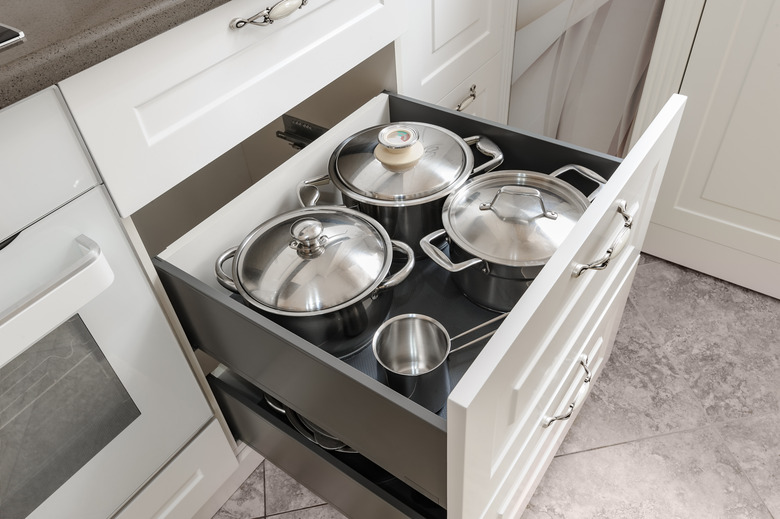How To Correct A Drawer Creep
Whether it occurs in the kitchen, the bathroom or the bedroom, drawer creep is off-putting and a little dysfunctional. When a drawer keeps opening on its own, it can catch your clothes as you walk by, and small, important things can roll in and — because you didn't see it happen — essentially disappear. Drawer creep indicates a lack of balance, but you can restore that balance.
Investigate a Drawer That Won't Stay Closed
Investigate a Drawer That Won't Stay Closed
If you're in the habit of loading stuff into the front of the drawer, the extra weight may be forcing it open, and you can probably cure your creeping drawer by rearranging what's inside. For example, if it's a kitchen utensil drawer, position a utensil holder strategically in the center to more evenly distribute the forks, knives and spoons.
File drawers tend to creep open when the heaviest books and files are in the front — put some of them in the back. Redistribution of its load may be all your drawer needs, but sometimes, no amount of reorganization helps; the drawer may creep even when it's empty. If so, don't worry; you're far from out of options.
Maybe It's the Cabinet
Maybe It's the Cabinet
The cabinet —or perhaps even the floor — may be tilted. To check, put a level on the top of the cabinet and watch the bubble — if it tends toward back of the cabinet, you may have diagnosed the problem. You can't always adjust the level of the cabinet, but if you can, do so by shimming the front feet with wood or plastic shims to bring the bubble to dead center.
When shimming isn't possible, the next strategy is to adjust the drawer glides and tracks. This is also the cure for a dresser drawer that doesn't stay closed when it's empty and the cabinet is level.
Adjust the Drawer Glides
Adjust the Drawer Glides
Drawer glides comes in a variety of styles, but no matter what company manufactured them, they almost always attach to the drawers and cabinet with screws. If your drawer glide has a screw loose, your course of action is simple, and all you need is a torpedo level, screwdriver and headlamp.
First, pull the drawer out of the cabinet. If you can easily wiggle it up and down while you're pulling, that's an indication of a loose fastener.
Put the drawer on a level surface, and set a torpedo level on one of the glides. If the glide is loose, move it up or down with your fingers until the bubble is centered, then tighten the screws with a screwdriver. If the screws aren't loose, but the bubble isn't centered, loosen the screws, adjust the glide to level it and tighten them. Adjust the other glide in the same way.
Make Sure the Tracks Are Level
Make Sure the Tracks Are Level
Put on a headlamp so you can see what you're doing and look inside the cabinet. Set the level on one of the tracks and check the bubble. Adjust the track, loosening the screws holding it if necessary, to center the bubble, then tighten the screws. Adjust the track on the other side of the cabinet in the same way.
Check the center track, if there is one. It may have come loose from the cabinet facing. If so, reattach it and tighten the screws. According to DC Drawers, replacing the tracks altogether is the next step to try if adjusting the tracks or glides doesn't solve the problem.
If the drawer or cabinet is made of particleboard, the screws may have gouged large holes, and you may not be able to tighten them. If that's the case, remove the affected glide or track, fill the holes with epoxy putty, and let it cure. Then, reinstall the glide or track, using the level to make it horizontal.
